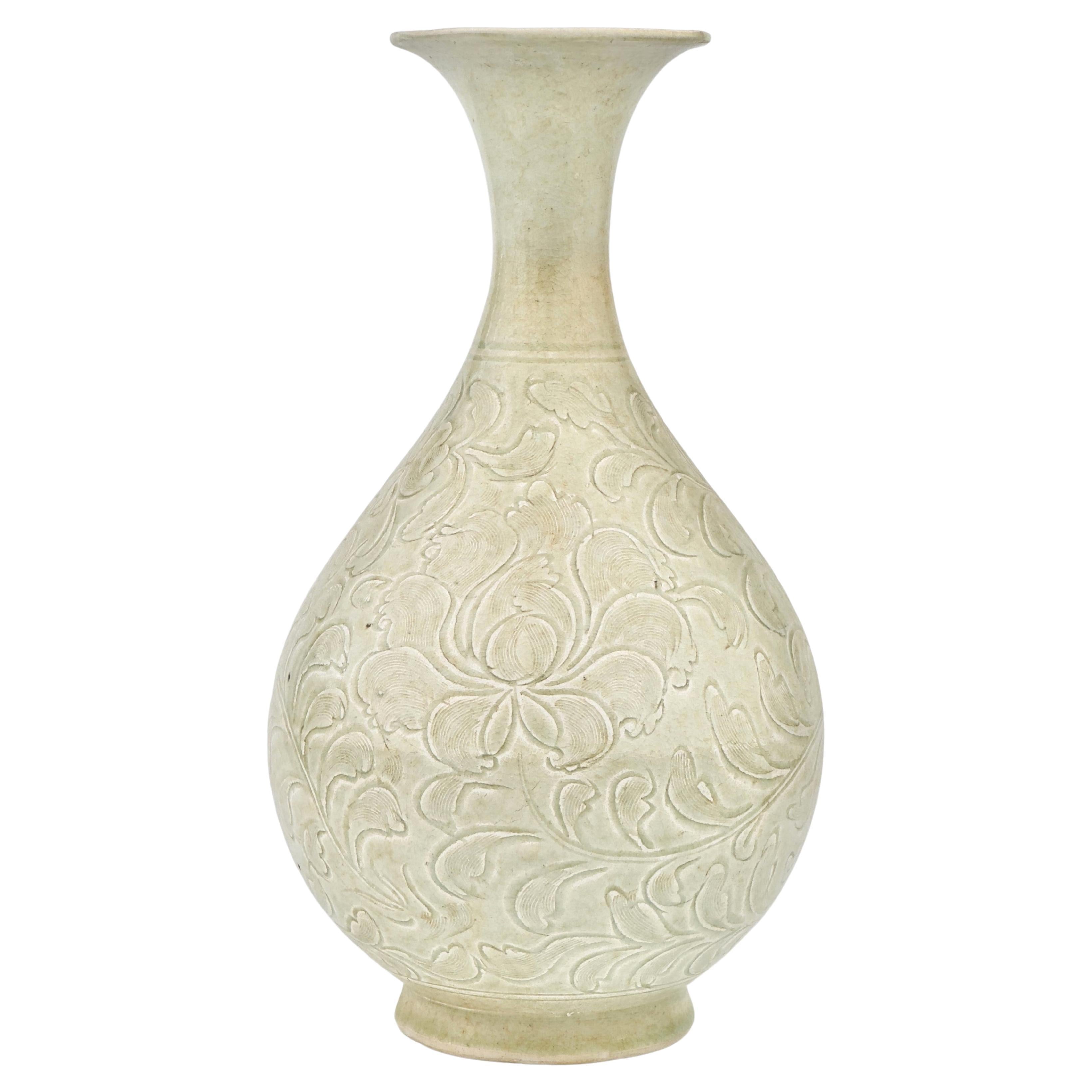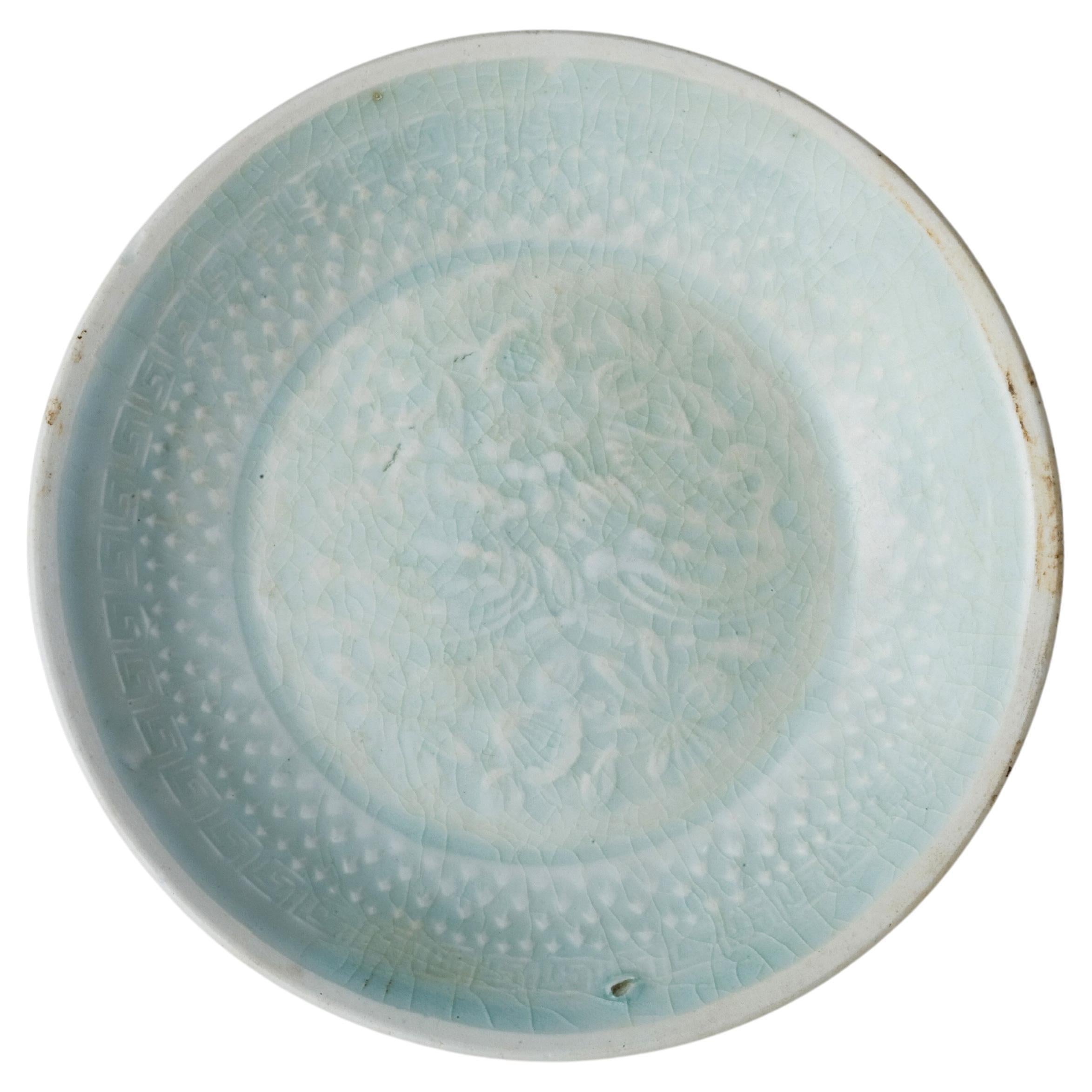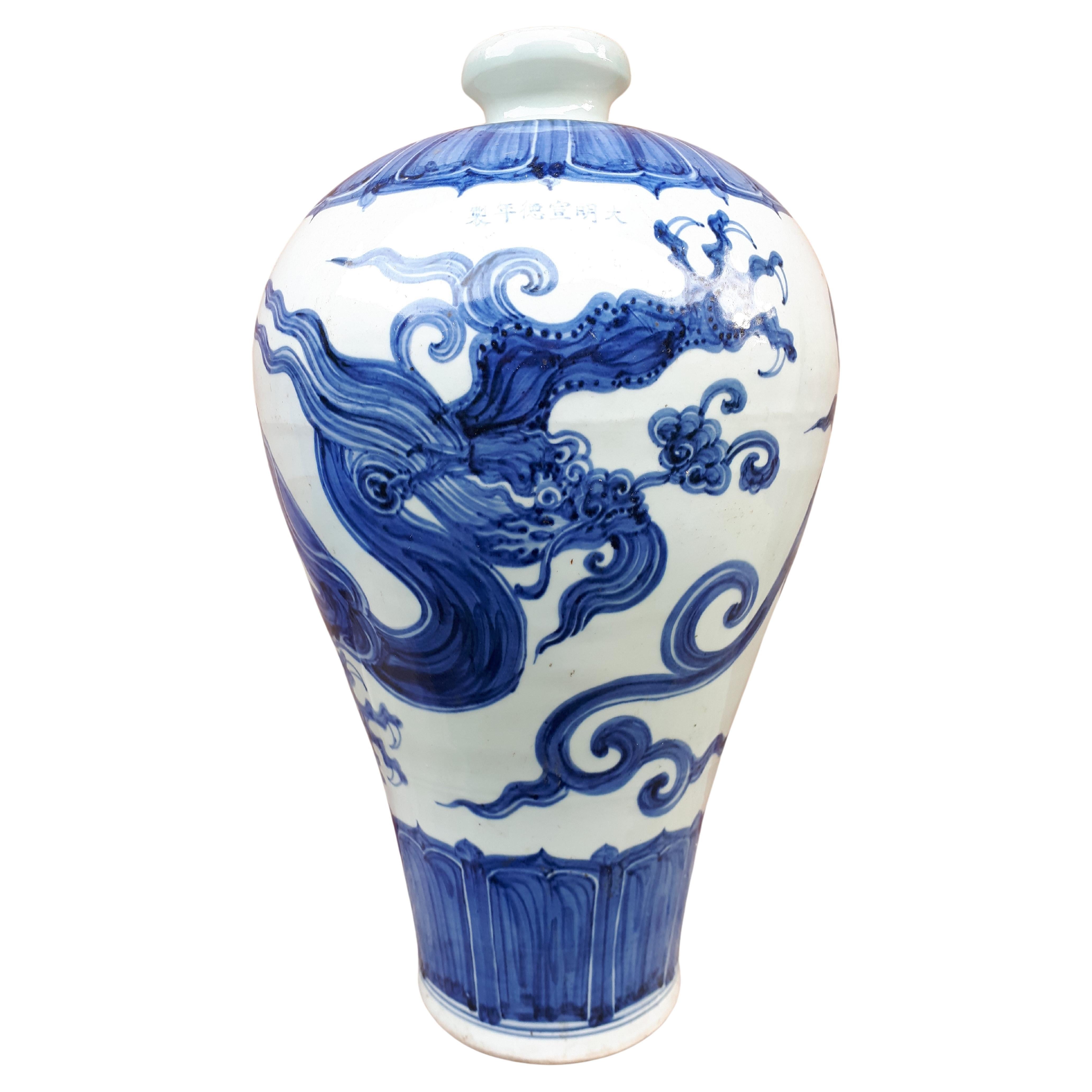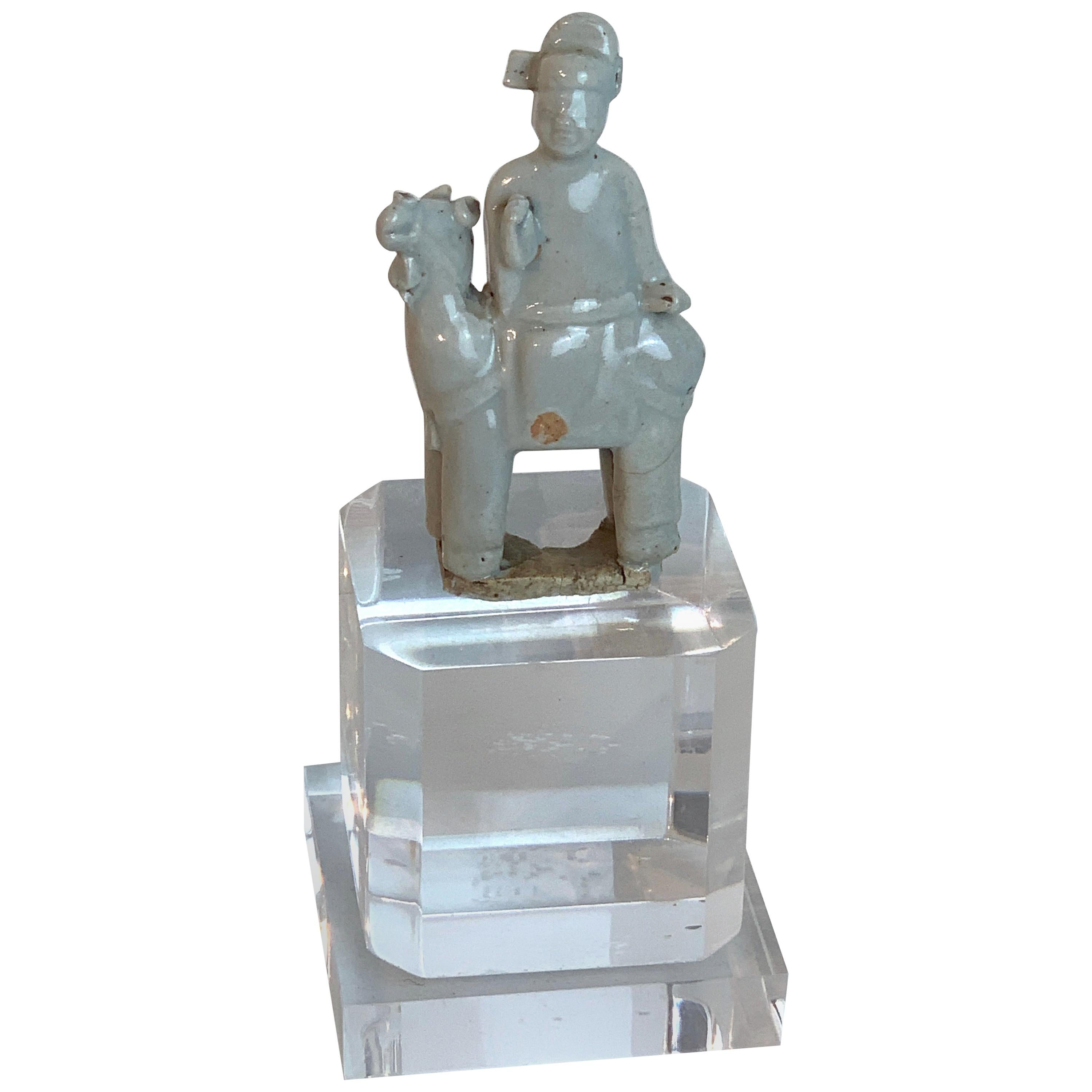Items Similar to A Qingbai Carved Meiping Porcelain, Song Dynasty
Want more images or videos?
Request additional images or videos from the seller
1 of 21
A Qingbai Carved Meiping Porcelain, Song Dynasty
About the Item
The vase exhibits a finely crafted structure, characterized by its wide shoulders and elongated, tapering sides, topped with a compact, ribbed cylindrical neck. Its exterior is adorned with intricately carved scrolling foliage motifs, accentuated by meticulously combed incisions. A delicate bluish glaze envelops the vase, with the entire surface embellished with elegantly incised patterns of leafy vines and flourishing lotus flowers. The last photo taken under different lighting shows the occurrence of a iridescence(rainbow light phenomenon).
Period : Song Dynasty(960~1279)
Type : Meiping
Medium : Qingbai Carved
Dimension : 32 cm(Height), 5cm(Mouth Diameter)
Provenance : Acquired in late 1990s from Hongkong
Reference :
1) Christie's London 13 MAY 2014 - Fine Chinese Ceramics and Works of Art - Lot 284
(Price : 13,750 GBP / Type : Closely related)
2) Christie's Paris 15 DEC 2010 - Art d'Asie - Lot268
(Price : 17,500 Euro / Type : Closely related)
* Qingbai Ware
Qingbai ware, which translates to "blue-white ware," is a type of Chinese porcelain that was made at the Jingdezhen and other kilns in the porcelain-producing regions of China, primarily during the Song dynasty (960–1279) and continuing into the Yuan dynasty (1271–1368). It is known for its translucent quality and the pale blue-green glaze that characterizes most of its pieces.
The qingbai glaze was achieved using a small amount of iron in a reduction-fired atmosphere, which produced the subtle blue-green tint. The body of qingbai ware is typically made of a fine, white porcelain that is often referred to as 'artificial jade' due to its resemblance to the esteemed stone. The thinness of the body and the high firing temperatures used contributed to the translucent quality of the finished product.
Qingbai ware includes a range of items such as bowls, cups, vases, and ewers. The designs are usually simple and elegant, with an emphasis on the graceful lines and form of the objects. Decorative motifs, when present, are often incised, carved, or molded in relief and can include floral patterns, dragons, phoenixes, and other symbolic elements drawn from Chinese culture.
Over time, the technology and techniques used to produce qingbai ware evolved, leading to innovations in glaze and decoration that would influence later types of Chinese porcelain. Despite these changes, qingbai ware remains a distinguished example of the potters' art in Song and Yuan China, reflecting the refined aesthetic and cultural values of the period.
- Dimensions:Height: 12.6 in (32 cm)Diameter: 1.97 in (5 cm)
- Style:Ming (Of the Period)
- Materials and Techniques:
- Place of Origin:
- Period:
- Date of Manufacture:960-1279
- Condition:Wear consistent with age and use. Minor damage in the mouth.
- Seller Location:seoul, KR
- Reference Number:1stDibs: LU9577239170172
About the Seller
New to 1stDibs
Joined in the past six months.
4.5
Vetted Seller
These experienced sellers undergo a comprehensive evaluation by our team of in-house experts.
Established in 1999
1stDibs seller since 2023
Typical response time: 1 hour
- ShippingRetrieving quote...Ships From: seoul, Korea South
- Return PolicyA return for this item may be initiated within 10 days of delivery.
More From This SellerView All
- Qingbai Yuhuchunping Vase Porcelain, Song DynastyLocated in seoul, KRCovered with a fine bluish glaze, the body entirely decorated with an incised decoration of elegant leafy scrolls and blooming lotuses. "Yuhuchunping" translates to 'spring wine bott...Category
Antique 15th Century and Earlier Chinese Ming Ceramics
MaterialsCeramic, Porcelain
- A Molded Qingbai 'Flowers' Dish, Southern Song DynastyLocated in seoul, KRThe plate depicted here exhibits the intricate floral patterns and lotus motifs that are typical of Southern Song designs. The central floral motif captures the essence of Oriental b...Category
Antique 15th Century and Earlier Chinese Ming Antiquities
MaterialsCeramic
- Chinese Qingbai Small Model of a Granary Set, Song DynastyLocated in seoul, KRTwo granary model porcelains. East Asia, This pottery representation of a granary sits on a layered base, topped with a conical lid that also acts as its roof, all finished in a grey...Category
Antique 15th Century and Earlier Chinese Ming Antiquities
MaterialsCeramic, Porcelain
- Qingbai Bowl with carving of crane, Song DynastyLocated in seoul, KRThe crane, a traditional symbol of longevity and auspiciousness, is prominently placed at the center, creating a harmonious and aesthetically balanced effect. The border of the dish ...Category
Antique 15th Century and Earlier Chinese Chinese Export Antiquities
MaterialsPorcelain
- Pair of Qingbai Funerary Vases with Daoist figures, Southern Song-Yuan DynastyLocated in seoul, KRA pair of large Qingbai jars from the Song or Yuan Dynasty, designed for tomb offerings, featuring tall proportions with short bodies and extended necks. These Mingqi jars, typically...Category
Antique 15th Century and Earlier Chinese Ming Vases
MaterialsCeramic, Porcelain
- Cizhou Lotus Carved Jar, Song-Yuan dynastyLocated in seoul, KRThis jar features a carved design, which is typical of Cizhou ware. It has a creamy white and brown color scheme, and the prominent decoration of lotus flower, which is a common motif in Chinese art and culture, symbolizing purity and enlightenment. The carving technique involves coating the vessel with a layer of white slip (liquid clay), then carving away parts of it to create the design, revealing the darker clay body beneath. This technique allows for a strong contrast between the background and the carved motif. Period : Song-Yuan Dynasty Type : Jar Medium : Cizhou Ware Size : 21.5 cm(Height), 11cm(Mouth Diameter) Provenance : Acquired in 1999, Hongkong * Cizhou Ware Cizhou is the name given to a number of stonewares, grey or buff, of varying degrees of hardness, with painted, incised or carved decoration on a clay slip. These stonewares were not only made in the region of Cizhou, Hebei Province, but in several provinces of China during the Song, Yuan and Ming periods. The great centres of production were in the north of China in the provinces of Hebei, Henan and Shanxi. Cizhou wares seem to have been very popular, made for a clientèle of rich merchants, at a period when the paintings of famous...Category
Antique 15th Century and Earlier Chinese Ming Antiquities
MaterialsPottery
You May Also Like
- Large Chinese Blue And White Vase In Meiping Shape, China Late Qing DynastyLocated in Saverne, Grand EstLarge Meiping-shaped porcelain vase with underglaze blue decoration of a dragon pursuing the sacred pearl. This rotating decoration of the dragon over the entire body of the vase was...Category
Early 20th Century Chinese Ming Ceramics
MaterialsPorcelain
- Song Dynasty Chinese Celadon Porcelain Horse and Rider on Later Lucite PedestalLocated in West Palm Beach, FLSong dynasty Chinese celadon porcelain horse and rider on later Lucite pedestal Chinese celadon porcelain horse and rider, likely Song dynasty (10th-13th century AD) The figure alo...Category
Antique 15th Century and Earlier Chinese Chinese Export Ceramics
MaterialsPorcelain
- 20th Century Chinese Celadon Porcelain Rice Bowl in Song Dynasty StyleLocated in Marbella, ES20th century Chinese celadon porcelain rice bow in the style of the Song dynasty. Celadon or greenware are glazed in the jade green color.Category
Late 20th Century Chinese Ceramics
MaterialsCeramic
- Song Dynasty, A Pair of Antique Chinese Porcelain Vases with Dragon and GodsLocated in Sampantawong, THA pair of Song Dynasty porcelain olive green vases decorated with gods around the vase and flying dragon on top of each vase. Each lid decorat...Category
Antique 15th Century and Earlier Chinese Antiquities
MaterialsStoneware
- Song Dynasty, A Pair of Antique Chinese Porcelain Vases with Dragon and GodsLocated in Sampantawong, THA pair of Song Dynasty porcelain olive green vases decorated with gods around the vase and flying dragon on top of each vase. Each lid decorated...Category
Antique 15th Century and Earlier Chinese Antiquities
MaterialsStoneware
- Chinese Longquan Celadon Ming Dynasty Porcelain VaseLocated in Bradenton, FLChinese Longquan Celadon Ming Dynasty Porcelain Vase. Chinese antique Ming Dynasty celadon porcelain vase with leaf motif. Overall crackle glaze.Category
Antique 17th Century Chinese Ming Ceramics
MaterialsPorcelain
Recently Viewed
View AllMore Ways To Browse
Japaneses Arita Imari Porcelain
Hand Painted Pagoda
Satsuma Wisteria
Liu Hai
Japan Satsuma Style Moriage Vase
Kyoto Teapot
Netsuke Porcelain
Rustic Temple Jar
Raku Sake
Tiger Transparent Vase
Pair Of Vintage Wall Lamps
Cart Black
Candelabra Art Deco
Spanish Revival Living Room
Brass Sconces Pair Large
Bamboo Chair With Cushion
Rope Twist Furniture
Dimension Coffee Table





